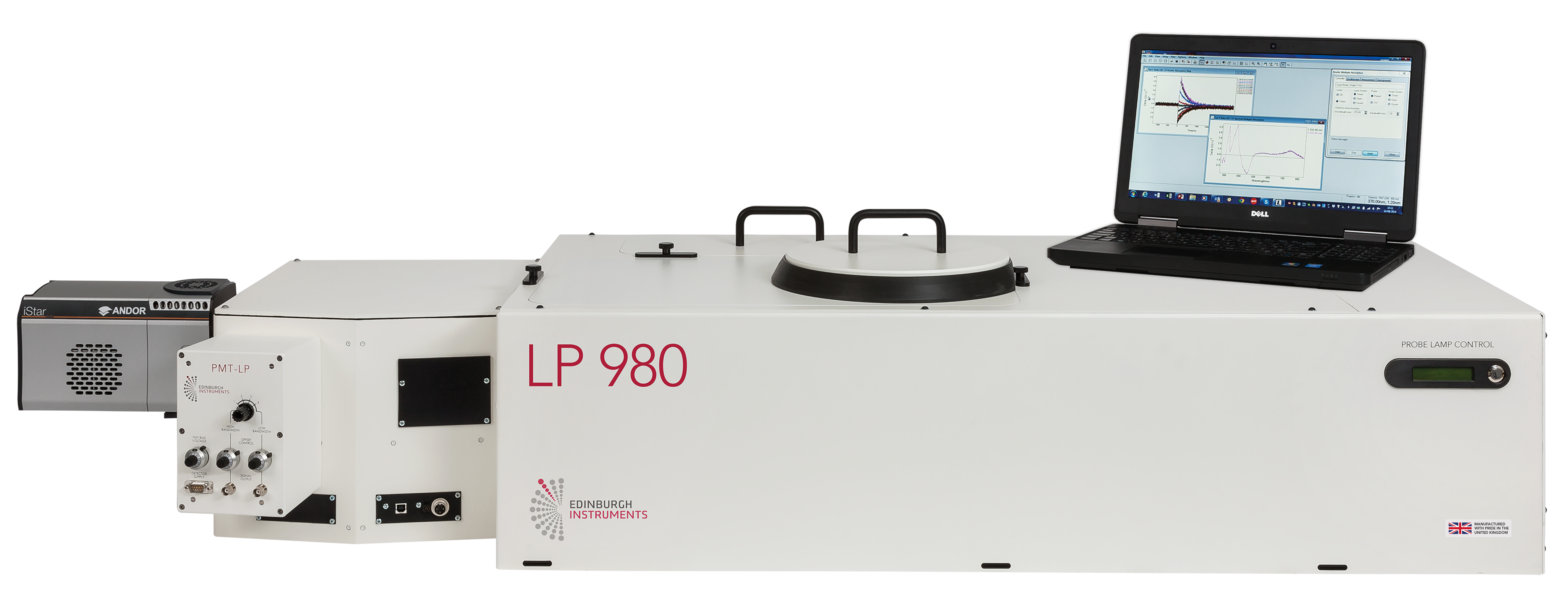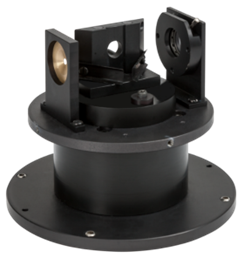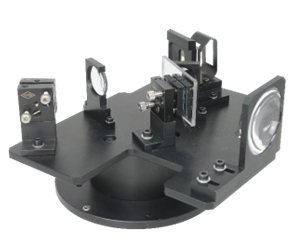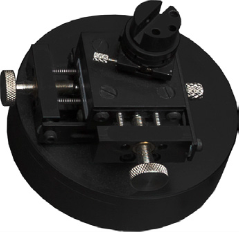
Accurate Kinetics
Over 9 orders of magnitude, from nanoseconds to seconds

Send us your samples, and we can measure them live in an online demonstration
Contact us to arrange an online demonstration

Accurate Kinetics

Wide Spectral Range

Advanced Accessories

Multiple Detectors

High Sensitivity

Multi-Technique
"*" indicates required fields
The LP980 Transient Absorption Spectrometer sets the benchmark in transient absorption research, becoming the go-to instrument for a wide array of photochemical, physical, and biological applications.
As the first of its kind on the market, the LP980 enables precise measurement of transient absorption (TA), laser-induced fluorescence (LIF), and phosphorescence up to 2.55 µm, with time scales ranging from nanoseconds to seconds. Its dual monochromator/spectrograph design allows for both spectral and kinetic acquisitions in one device, saving you both time and cost.
Available in two models—LP980-K (kinetic PMT detector) and LP980-KS (kinetic PMT and spectral ICCD detector)—the LP980 can be customised with various pump lasers, probe sources, sample holders, and detectors to perfectly match your research needs. Our technical sales team is ready to help you configure the ideal setup for your experiments.
With the intuitive L900® software package, data acquisition is straightforward, and comprehensive analysis tools like ΔOD calculations and multi-component decay fitting are included, eliminating the need for additional software.
The L900 software package streamlines every aspect of the LP980, from parameter optimisation and data acquisition to analysis and control of third-party accessories. With everything integrated into a single, user-friendly platform, there’s no need for additional upgrades.
Figure 1: L900 software interface
Before measurement, users can preview and optimize signal intensity, significantly reducing experimental time. The software offers comprehensive spectral calibration, automatic subtraction of camera dark noise, and generates automated maps of time, wavelength, and temperature when paired with the relevant accessories. Decay fitting and other analysis features are also built-in.
For advanced transient absorption curve fitting, the FLASH software package is available.
Nanosecond TA is an ideal technique for probing the kinetics of triplet states generated by a laser pulse. A key application is the characterisation of photosensitisers for catalysis or photodynamic therapy.
In Figure 1, the TA decay of anthracene is measured in LP980 at different laser energies. Higher laser energies increase the concentration of triplet states, resulting in quenching by triplet-triplet annihilation which leads to a reduced lifetime.
Figure 1: TA decay of anthracene
Figure 2 shows the absorption kinetics of the triplet state of anthracene in cyclohexane measured at 423 nm at three pump laser energies: Epump = 50 mJ (blue), Epump = 10 mJ (red), Epump = 1 mJ (green). Normalised ΔOD traces (bottom) illustrate how the lifetime decreases as pump energy increases.
Figure 2: Absorption kinetics of the triplet state of anthracene
The LP980 can routinely measure laser-induced fluorescence using the standard PMT detector or InGaAs analogue infrared detector. Detection of singlet oxygen by luminescence, however, requires a highly sensitive NIR PMT and photon-counting electronics (multichannel scaling, or MCS). The LP980 can be equipped with such an upgrade, which removes the need for a second spectrometer for singlet oxygen detection.
Figure 1: NIR phosphorescence decay from 1O2 acquired in LP980 exciting rose Bengal with 532 nm Nd:YAG laser pulses (laser scatter subtracted from the data) and MCS detection. The exponential fit result is shown in the graph.
The ICCD spectral detector provides the full TA spectrum at a user-set delay after the pump pulse. Although the same information can be obtained with the standard PMT (kinetic) detector, the ICCD offers faster results minimising lab time and sample exposure to the pump and probe light. Therefore, it is particularly recommended for light-sensitive samples.
A typical TA spectrum shows positive bands from absorption of photogenerated excited states, and negative bands from ground state bleaching and laser-induced fluorescence. The spectral acquisition can be mapped as a function of time to observe the temporal evolution of each transient, as shown in the example below.
Figure 1: TA spectrum of [Ru(bpy)3]2+ in water as a function of time after 355 nm laser excitation. Transient absorption, ground state depletion, and fluorescence bands indicated in the graph.
Laser-induced fluorescence and phosphorescence spectra are readily acquired with the ICCD detector in the LP980 spectrometer. In the example below, a software-controlled cryostat accessory was used to cool a sample down to 77 K, increasing the intensity of phosphorescence. A map of the emission spectrum as a function of time, automatically acquired in the software, reveals the timescale of the luminescence decay.
Figure 1: LIF spectra from benzophenone in 4:1 ethanol/methanol at 77 K in cryostat and at room temperature (red curve) acquired with the ICCD camera. Delays between pump pulse and ICCD acquisition indicated in the graph.
The generation of spectra in kinetic mode by successive measurement at different wavelengths requires many excitation flashes. This can be problematic due to photo-degradation of the sample over time. This can be overcome by upgrading to spectral mode and fitting an ICCD onto the instrument, converting an LP980-K into an LP980-KS.
The ICCD detector has a high dynamic range, 7 ns temporal resolution, and is controlled by the L900 software.
Standard sample holder of the LP980. Laser beam and probe beam intersect perpendicular at the sample position.

Suitable for opaque and highly scattering powders, solids and suspensions.

Maximises overlap between pump and probe increasing transient absorption signal.

Films are mounted vertically at an angle from the pump and probe beams. Features control of X,Y position and rotational angle for maximum alignment flexibility.

Fits standard cuvettes and is placed near the detection monochromator, for enhanced fluorescence collection compared to the standard TA holder.
Transient absorption sample holder with TE control by the L900 software. Options from -50 oC to +150 oC are available.
Low-cost option for cryogenic measurements of liquids and powders at 77 K.
Liquid N2 or He cryostats are mounted in the TA sample position and easily exchanged for other holders. They are fully controlled from the software enabling the creation of automated temperature maps.
The standard kinetic detector in LP980 covers the range of 200 nm – 980 nm. This can be replaced by a PMT980 (200 nm – 980 nm) or PMT1010 (200 nm – 1010 nm) detector for TA extending further into the NIR.
A range of analogue InGaAs detectors are available to cover the range of 900 nm – 2550 nm (LIF-only detection between 2050 nm and 2550 nm).
For weak laser-induced fluorescence signals in the NIR, a photon-counting NIT PMT and MCS electronics upgrade is recommended.
| LP980 Base Configuration | Specification |
|---|---|
| Monochromator | Czerny-Turner with triple grating turret, 325 mm focal length, 25 µm to 10 mm computer-controlled (continuously adjustable) motorised slits |
| Laser Excitation Source | Flashlamp pumped Q-switched Nd:Yag laser operating at 1064 nm, 532 nm, 355 nm or 266 nm. OPO, tuneable in the range 410 nm - 710 nm (signal). Idler and UV doubler options possible |
| Sample Geometry | Transverse sample excitation geometry included as standard |
| LP980-K (Kinetic Mode) - for lifetime transient decay measurements at a single wavelength | Specification |
|---|---|
| Grating | Plane ruled grating, 1800 g/mm, 500 nm blaze as standard |
| Dispersion | 1.8 nm/mm |
| Spectral Range | 200 nm - 870 nm |
| Spectral Resolution | 0.1 nm |
| Sensitivity | ΔOD 0.002 (single shot - fast detector option, PMT), ΔOD 0.0005 (single shot - slow detector option, ICCD) |
| Detector Type | Photomulitplier (PMT) with 5 stage dynode chain for high current linearity |
| Detector Impedance | 50 Ω (amplified - fast detector, <3 ns rise time), 1 kΩ (slow detector, <100 µs rise time) |
| LP980-KS (Kinetic & Spectral Mode) - for lifetime transient decay measurements AND spectral measurements of the decay process | Specification |
|---|---|
| Grating | Kinetic mode grating plus an additional plane ruled grating: 150 g/mm, 500 nm blaze supplied |
| Dispersion | 21.6 nm/mm |
| Spectral Coverage | 540 nm (active horizontal ICCD dimension: 25 mm) |
| Spectral Resolution | 0.56 nm (spectral coverage / 960 pixels) |
| Sensitivity | ΔOD 0.0005 single shot |
| Detectors | Kinetic mode PMT plus an additional image intesified CCD camera (ICCD) supplied |
| Min. Optical Gate Width | 7 ns (FWHM) |
| Active Pixels | 960 x 256 |
| Active Area | 25 mm x 6.7 mm |
| Cooling | -20°C as standard (-35°C with additional water circulation) |
| LP980 Upgrade Options | Specification |
|---|---|
| Gratings | A variety of gratings with 150 g/mm - 2400 g/mm, optimised from UV through to NIR |
| Sample Holders | Cross-beam geometry, diffuse reflectance, thin-film accessory |
| Detectors | InGaAs detectors (900 nm - 2550 nm) for NIR range are available |